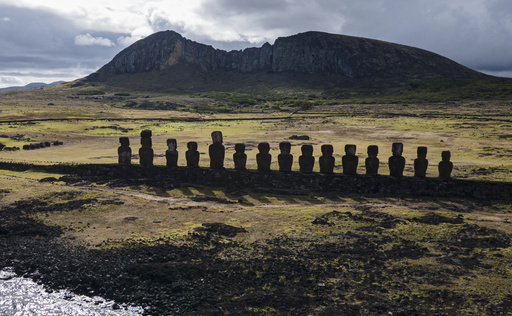
COPENHAGEN, Denmark — A museum in Oslo is returning artifacts and human remains collected by Norwegian explorer and anthropologist Thor Heyerdahl during the late 1940s to Easter Island, also known as Rapa Nui, in the mid-Pacific, as announced by the Kon-Tiki Museum on Wednesday.
Heyerdahl embarked on an expedition in 1947, sailing a log raft named Kon-Tiki from Peru to Polynesia over the course of 101 days. His aim was to validate his theory that the South Sea Islands were originally settled by seafaring peoples from South America.
Heyerdahl brought back over 5,600 items from Easter Island, marking the third occasion that his collections are being returned to their rightful place. Most of these artifacts have remained in storage or on display at the Kon-Tiki Museum, located in Norway’s capital. Previous returns occurred in 1986 and again in 2006, with the current return made possible through collaboration between the museum, Chile, and Rapa Nui’s local authorities.
Liv Heyerdahl, the granddaughter of the explorer and head of the museum, expressed pride in the occasion. She remarked to a Norwegian news outlet that the artifacts were taken under a commitment that they would eventually be sent back.
Among the items being returned are human remains named Ivi Tepuna along with sculpted stones. A nine-member delegation from Rapa Nui traveled to Norway to retrieve these items, with four members spending the night at the museum alongside the remains. This was part of a ceremonial process intended to honor the spirits of the remains.
Laura Tarita Rapu Alarcón, a delegate, described the ritual, emphasizing the importance of awakening and communicating with the spirits in their native language, followed by preparing food for a meal shared with the spirits.
Liv Heyerdahl highlighted the necessity of involving those connected to the culture in returning the remains, asserting that it is only right for the artifacts to be returned to Rapa Nui.
In 2019, a formal agreement concerning the return of the items was signed in Santiago, Chile, during a visit by Norway’s King Harald, but the COVID-19 pandemic halted progress on the initiative in 2020.
Thor Heyerdahl’s journey has been immortalized in literature and film; his book detailing the voyage has become a worldwide bestseller, and the documentary of his adventure earned an Academy Award in 1951.
Easter Island is renowned for its iconic moai—large monolithic statues crafted by the Rapa Nui people centuries ago. This remote volcanic island spans approximately 164 square kilometers (63 square miles), hosting around 7,700 residents, about half of whom are of Rapa Nui descent.
Geologically speaking, Easter Island was formed by volcanic activity over 750,000 years ago, making it one of the most isolated inhabited locations in the world, situated 3,700 kilometers (2,300 miles) from the South American coast. It received UNESCO World Heritage Site designation in 1995 and, in 2019, was officially renamed “Rapa Nui-Easter Island” from its previous designation of simply Easter Island.
